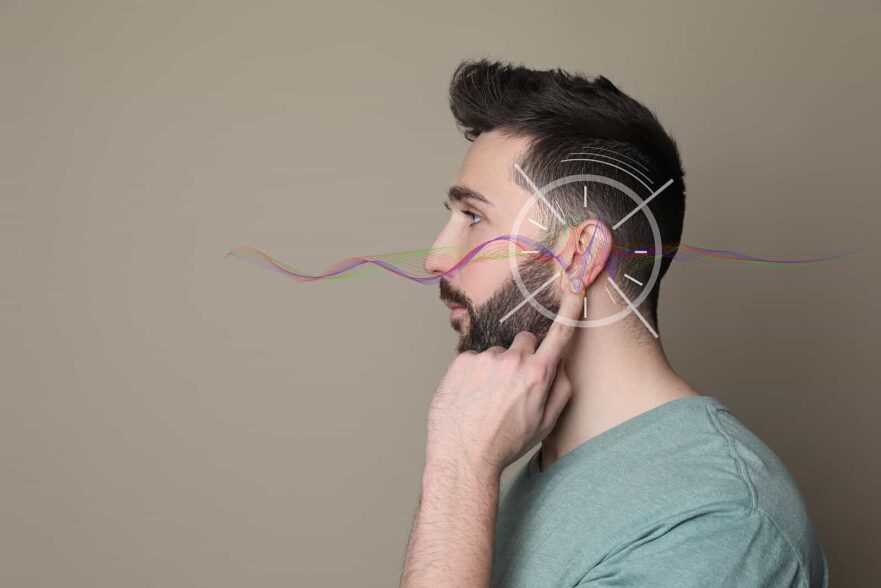Hearing loss is a health condition that impacts over 48 million people. Though hearing loss is the third most common medical issue that people live with today, it still remains widely underdiagnosed and undertreated. Untreated hearing loss not only impacts hearing and communication, but it often has multifaceted effects that can take a toll on health and wellness. It is important to be aware of the symptoms of hearing loss so that you can recognize any changes you may experience to your hearing health over time.
Conductive Hearing Loss
Conductive hearing loss is a type of hearing loss that takes place in the outer or middle part of the ear. It is caused when soundwaves are prevented from moving through the ear canal and reaching the inner ear. This causes them to not be fully absorbed and processed as the brain receives less of these signals, producing hearing loss.
- Causes: there are several factors that can obstruct soundwaves from flowing through the ear. A few common causes include: issues with the eardrum – perforation, a tare, inflammation etc.; accumulated earwax in the ear canal, breakage or other issues with the bones in the middle ear, ear infections, fluid in the space between the eardrum and the cochlea, foreign objects that get lodged in the ears (more common among kids) etc.
- Symptoms: conductive hearing loss produces various symptoms including distorting or muffling sounds, pain or tenderness in the ears, feeling like the ears are full, ear pressure, tinnitus – a buzzing or ringing like noise in the ears, dizziness, drainage from the ear, sudden loss of hearing etc.
- Treatment Options: there are several ways conductive hearing loss is treated. Treatment options depend on the underlying cause so being assessed by a specialist is the first step. Treatment options can include surgical interventions to repair any damage of the bones in the middle ear, eardrum, growths etc. It can also include thorough removal of earwax that may have accumulated in the ears and treating ear infections.
Conductive hearing loss is often temporary and once the underlying issue is addressed, hearing is usually restored.
Sensorineural Hearing Loss
Sensorineural hearing loss differs from conductive hearing loss in major ways. This type of hearing loss occurs in the inner ear when sensory cells are damaged. There are thousands of sensory cells in the inner ear (in the cochlea) and they play an integral role in how sound is processed. These cells convert incoming sound waves into electrical signals that get sent to the brain. The brain continues processing these signals, including assigning meaning to them which is how we understand what we hear. When sensory cells are damaged, their ability to process soundwaves effectively is impaired, resulting in the brain receiving less auditory information and this causes hearing loss.
- Causes: there are several ways sensorineural hearing loss can be caused. A few of the most common causes include: aging, one time or regular exposure to loud noise, existing medical conditions – cardiovascular disease, hypertension, diabetes, osteoporosis, head injuries, chronic ear infections, autoimmune conditions, and ototoxic medications.
- Symptoms: sensorineural hearing loss produces a number of symptoms including: tinnitus – a ringing or buzzing like noise that only you can hear, sounds are distorted or muffled, recognizing individual words is challenging, lip reading, asking others to repeat what they said, hearing more clearly out of one ear compared to the other, and increasing the volume on electronic devices.
- Treatment Options: sensorineural hearing loss is a permanent type of hearing loss. This means that there are no ways to cure or restore hearing. Fortunately, there are effective ways that it is treated. Hearing aids are the most common treatment for sensorineural hearing loss. Hearing aids are electronic devices that absorb and process speech as well as sound. This provides ample support that alleviates symptoms and maximizes one’s capacity to hear.
Sensorineural hearing loss is by far the most common type that people experience today. It is estimated that 9 out of 10 cases of hearing loss is the sensorineural type.
Prioritize Your Hearing Health Today
You can prioritize your hearing health by scheduling an appointment for a hearing test. Hearing tests involve a painless process that comprehensively evaluates your hearing capacities. Contact us today to schedule a hearing consultation!

